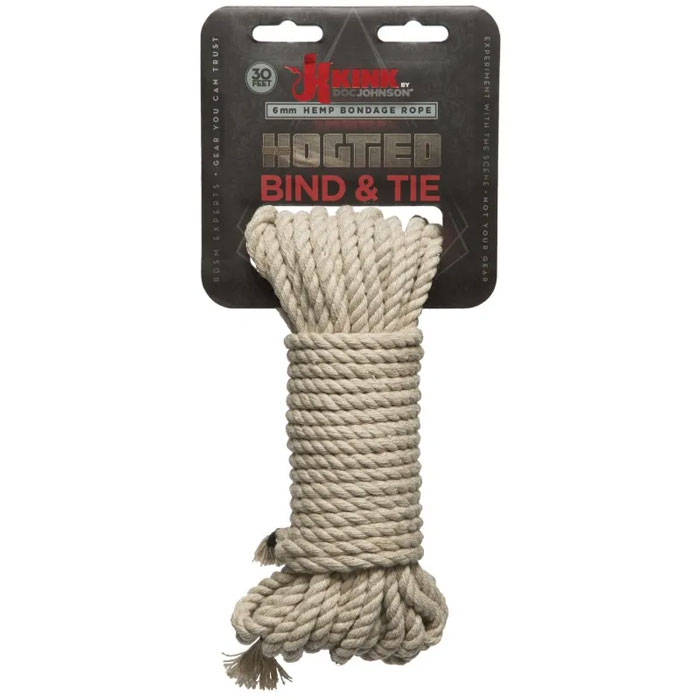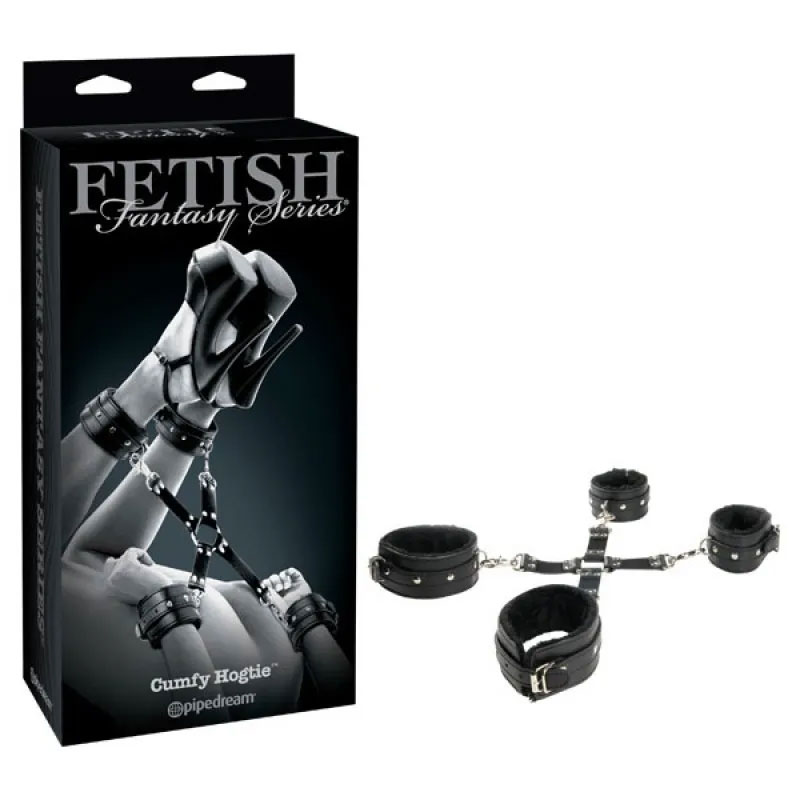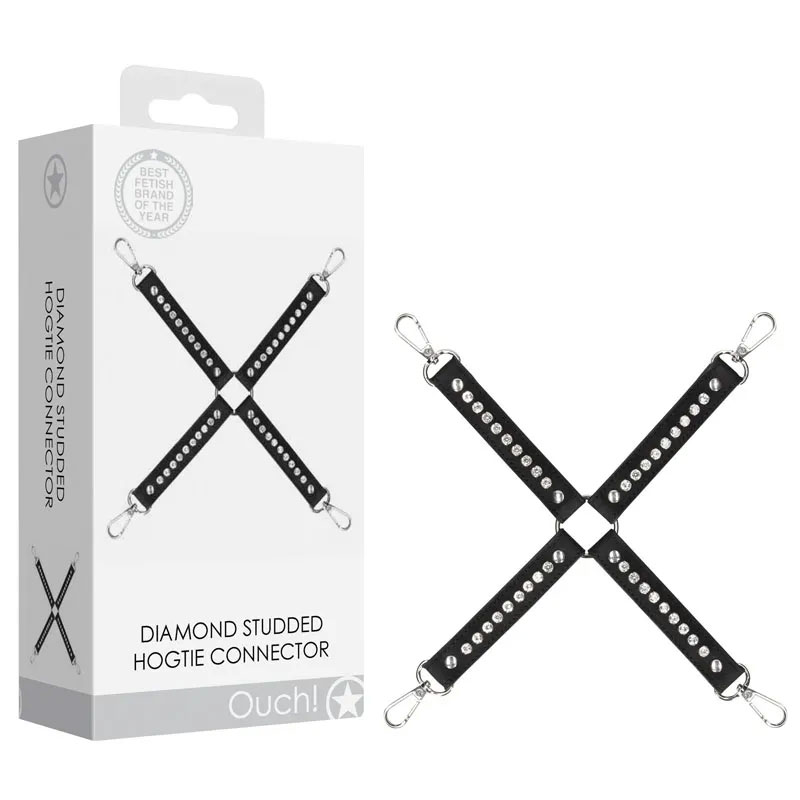
Curious about the art of hogtie and its safety measures? Wondering what products are best to use for this type of bondage play?
In this article, we'll explore hogtie, the safety precautions you should take, and the best products for a successful session.
Find out how to safely hogtie someone with a step-by-step guide, ensuring a pleasurable and consensual experience for all parties involved. Let's dive in and explore the world of hogtie together.
What is a Hogtie?
Hogtie is a form of rope bondage where a person’s ankles and wrists are bound together behind their back, creating a restrictive and immobilizing position often used in BDSM and roleplay scenarios.
Originating from the art of Japanese rope bondage, known as shibari, hogtie is deeply embedded in the intricate techniques and rich history of traditional rope tying. In Shibari, the focus is not solely on restraint but on the aesthetic beauty and emotional connection between the binder and the bound individual.
Tying someone up, whether for pleasure, discipline, or simply exploring power dynamics, has gained popularity across different cultures and subcultures. It requires trust and communication between the participants to ensure safety and enjoyment.
Is Performing a Hogtie Safe?
Hogtie can be safe when proper safety precautions and guidelines are followed, ensuring that participants communicate effectively and prioritize physical safety.
Consent is key in any BDSM practice, and hogtie is no exception. Clear communication before, during, and after the session is crucial to ensure that all parties are comfortable and aware of boundaries. Shelby Devlin recommends regularly checking in with each other to affirm consent and well-being.
Monitoring the individual's physical well-being is vital when engaging in a hogtie. Keeping a constant eye on the bound individual's circulation, breathing, and comfort levels is essential for a safe and enjoyable experience.
What Products Can Be Used to Hogtie Someone?
Various products can be used for hogtie, including different types of ropes, handcuffs, bondage tape, and specialised bondage gear designed to ensure both safety and immobilization during the practice.
1. Rope
A rope is one of the most versatile and commonly used BDSM tools for hogtie, with various types offering different levels of comfort and security depending on the material and knot techniques used.
Among the different types of ropes, jute stands out for its durability and texture. Hemp ropes, known for their strength, are favoured by many due to their rougher feel, which adds to the overall sensation. Conversely, cotton ropes, though softer, may not provide the same level of security as jute or hemp.
In terms of bondage, practising knots is essential for the safety and enjoyment of all parties involved. Techniques such as the single-column tie and double-column tie are fundamental skills that ensure proper tension and minimize the risk of injury during restraint.
Best Hog Tie Rope
The best ropes for hogtie are often those specifically made for shibari, such as the Single-Column Shibari Tie and Double-Column Shibari Tie ropes, which offer both durability and comfort during use.
KINK Hogtied Bind & Tie Rope
The KINK Hogtied Bind & Tie Rope is highly recommended for hogtie due to its perfect balance of strength and flexibility, making it suitable for secure yet comfortable bondage.

2. Handcuffs
Handcuffs are another popular tool used in hogtie, providing a quick and secure way to bind the wrists and ankles, often utilized in various BDSM scenarios.
When considering which type of handcuffs to use for hogtie, several options are available to cater to different preferences and needs. Metal handcuffs are sturdy and offer a classic restraint experience. Leather handcuffs provide a softer feel and can have adjustable straps for a customizable fit. On the other hand, padded handcuffs prioritize comfort with cushioned material that reduces strain on the skin during prolonged wear.
Best Handcuffs for Hogtie
Fetish Fantasy Series Limited Edition Cumfy Hogtie
The Fetish Fantasy Series Limited Edition Cumfy Hogtie is designed to offer maximum comfort and security, making it an excellent choice for those looking to explore hogtie safely.
This hogtie is made from high-quality materials and features soft and padded wrist and ankle cuffs, ensuring a pleasant experience without discomfort. The durable straps provide a secure hold while allowing for easy adjustments to fit various body sizes. Its thoughtful design allows for effortless restraint, giving the user full control over their partner's positioning. The Cumfy Hogtie stands out for its attention to user comfort, ensuring a pleasurable and safe hogtie experience.

3. Hogtie Connector
A Hogtie connector is a specialized piece of bondage gear used to link the wrist and ankle restraints together, providing a secure and immobilizing bond that enhances the hogtie experience.
Various types of hogtie connectors are available, including leather straps, metal clips, and ropes, each offering a different level of comfort and restriction. Leather hogtie connectors are popular for their durability and aesthetic appeal, while metal clips provide a more secure hold. Ropes, on the other hand, allow for greater flexibility in positioning. These connectors play a crucial role in enhancing bondage techniques, allowing for a more intense and physically demanding hogtie experience that can add an extra layer of excitement and challenge. By securely linking the restraints together, they ensure that the submissive partner stays in a restrained and vulnerable position, amplifying the power dynamics and heightening the overall sensory experience.
Best Hogtie Connector
Ouch! Diamond Studded Hogtie
The Ouch! Diamond Studded Hogtie stands out with its aesthetic appeal and practical functionality, offering a secure and stylish option for bondage play.

One of the unique aspects of the Ouch! Diamond Studded Hogtie lies in its premium quality material. Crafted with supple leather and adorned with sparkling crystals, this hogtie elevates the bondage experience to a luxurious level. The intricate design not only enhances the visual allure but also ensures durability and comfort during use. Users appreciate the attention to detail in the construction of this hogtie, making it a popular choice among those seeking both elegance and functionality in their bondage accessories.
4. Bondage Tape
Bondage tape is a versatile and non-sticky alternative to ropes and handcuffs, providing an easy-to-use option for creating restraints during hogtie and other bondage activities.
One of the key benefits of bondage tape is its simplicity and versatility. Unlike ropes that require intricate tying techniques or handcuffs that may be bulky and uncomfortable, this tape adheres to itself, allowing for quick and adjustable bondage scenarios. Its non-sticky nature makes it comfortable for the skin, eliminating potential chafing or irritation.
Best Bondage Tape for Hogtie
Adora 15M Bondage Tie-Up Restraint Tape
The Adora 15M Bondage Tie Up Restraint Tape in black is highly recommended for hogtie due to its non-sticky nature, making it easy to use and remove without causing discomfort.
This tape's length of 15 meters provides ample scope for creative and intricate bondage arrangements, allowing users to experiment with various ties and restraints. Crafted from a durable and flexible material, the tape ensures secure and reliable bondage play while remaining comfortable against the skin.

What are the Steps to Hogtie Someone?
Hogtying someone involves several careful steps to ensure safety and comfort, starting with choosing a safe location and discussing boundaries and safety words, and ending with monitoring the bound person.
Here is a video demonstration of someone being hogtied:
1. Choose a Safe and Comfortable Location
Choosing a safe and comfortable location for hogtie is crucial to ensure both participants feel secure and consent to the activity without any risk of injury.
Privacy is a key consideration when selecting a location for hogtie, ensuring that the activity remains intimate and secluded. The setting should offer a sense of comfort, with adequate space for movement and relaxation.
Physical safety is paramount, so it's essential to assess any potential hazards in the chosen area. Clearing any sharp objects or clutter can prevent accidents during the session.
2. Discuss and Establish Boundaries
Before beginning a hogtie session, it is essential to discuss and establish clear boundaries, including the use of a safe word to ensure open communication and mutual understanding.
A safe word plays a crucial role in BDSM activities as it serves as a quick and effective way to communicate discomfort or the need to stop without breaking the role-play atmosphere. This ensures that both parties feel secure and respected throughout the session, enhancing the overall experience. By openly discussing limits and boundaries beforehand, participants can create a more enjoyable and safe environment for exploration and experimentation.
3. Prepare the Tools
Preparing the tools for hogtie involves gathering the necessary bondage gear, including ropes, handcuffs, or tape, and ensuring you are familiar with the basic knots and ties.
Before starting, it's crucial to practice the art of knot tying. Mastering key knots like the square knot, slip knot, and double column tie is essential for safe and effective bondage play. Each tool has its purpose; ropes provide versatility and flexibility in binding, handcuffs offer quick restraint, and tape allows for creative positioning. Understanding how to adjust tension and securely fasten each piece of gear ensures both comfort and safety for the bound partner.
4. Tie the Ankles Together
The first step in physically restraining someone in a hogtie is to tie their ankles together using a secure knot, such as a single-column tie, to ensure they are bound comfortably and safely.
When tying the ankles together, it is crucial to create a loop with the rope and wrap it around both ankles in a figure-eight pattern to evenly distribute the pressure. The single-column tie technique is recommended for its effectiveness in keeping the ankles securely bound without causing discomfort or cutting off circulation. Ensuring the knot is neither too loose nor too tight is paramount for the person's safety and comfort.
5. Tie the Wrists Together
Next, tie the wrists together using a double-column tie, ensuring that the knots are secure but allow for some movement to prevent discomfort or circulation issues.
Begin by wrapping the rope around both wrists, ensuring that it is snug but not too tight. Cross the rope over itself to create two parallel columns of rope between the wrists.
- Bring the ends of the rope underneath the parallel columns, then loop them over the top and back through the space between the wrists.
- Make sure to tighten the loops evenly on both sides to maintain balance and prevent uneven pressure.
- Check with the individual regularly to ensure they are comfortable and can feel their fingers to maintain proper circulation.
This technique not only secures the wrists effectively but also prioritizes the well-being of the individual involved.
6. Connect the Ankles and Wrists
Using a hogtie connector or additional rope, link the ankles and wrists together behind the back, ensuring the connection is secure and the bound person is in a comfortable position.
Connecting the ankles and wrists serves as a fundamental step in various bondage practices, ensuring restriction and submission. By utilizing a hogtie connector, the limbs are securely bound in a way that restrains movement effectively while maintaining a degree of comfort for the bound individual.
7. Check for Comfort and Circulation
After securing the bonds, it's crucial to check for comfort and circulation, ensuring that the bound person's extremities are not numb or in pain and they can communicate any discomfort.
One way to assess comfort and circulation is by gently feeling the bound person's fingers and toes to ensure they are not overly constricted. Look out for coolness, paleness, or swelling, as these could indicate poor circulation.
8. Monitor and Communicate with the Bound Person
Continuously monitor and communicate with the bound person throughout the hogtie session, using the established safety word or signals to ensure they feel safe and heard.
The ongoing communication and monitoring during a hogtie session serve as crucial elements in maintaining a safe and enjoyable experience for both participants. It is imperative for the dominant partner to pay close attention to the bound person's verbal and non-verbal cues, ensuring that they are comfortable and their boundaries are respected.
By establishing clear safety words and signals beforehand, any potential issues or discomfort can be communicated effectively, allowing for immediate adjustments or the termination of the activity if necessary. This proactive approach not only enhances trust and communication between partners but also prioritizes the well-being of the bound individual.
Frequently Asked Questions
What does it mean to hogtie someone?
Hogtying is a bondage technique that involves tying a person's hands and feet together behind their back, often with their knees bent. It is a popular method of restraint in BDSM play.
Is hogtying safe?
As with any type of bondage, there are risks involved in hogtying. It is important to communicate with your partner and establish a safe word before engaging in any type of play. Proper technique and monitoring of the restrained partner's comfort and circulation are also crucial for safe play.
What materials can I use to hogtie someone?
There are various types of bondage restraints that can be used for hogtying, such as rope, leather cuffs, or even scarves or neckties. It is important to use strong and durable materials that will not cause harm to the restrained person.
How do I position the person for hogtying?
The person being tied should lie on their stomach with their hands and feet close together. Their knees should be bent, and their arms and legs should be at a 90-degree angle. This position will ensure comfort and safety during the tying process.
Are there any safety tips I should follow when hogtying someone?
Yes, it is important to avoid tying the restraints too tightly, as this can restrict circulation and cause discomfort or injury. It is also crucial to regularly check on the person's comfort and circulation throughout the play. Additionally, have a pair of safety scissors nearby in case the restraints need to be quickly removed.
How can I incorporate hogtying into my play safely?
Communication, trust, and consent are key when incorporating any type of bondage into your play. Discuss boundaries and establish a safe word before engaging in hogtying. Start slowly and build up gradually to ensure the comfort and safety of both partners.






Leave a Comment